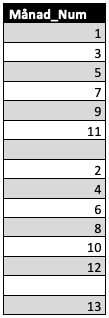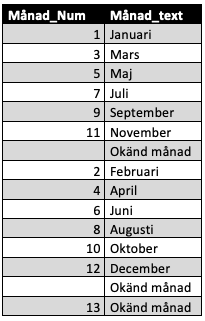Formelspråket som används i Power BI heter DAX. Språket utgörs av ett stort antal funktioner med konstanter och operatorer vilka används i formler och uttryck för att beräkna ett eller flera värden. DAX skapar helt enkelt ny information utifrån data som redan finns i din datamodell.
Funktionerna i DAX delar vi in i följande grupper: DATETIME, FILTER, INFO, LOGICAL, MATHTRIG, PARENTCHILD, STATISTICAL, TEXT, TIMEINTELLIGENCE samt OTHER.
DAX Function: SWITCH
Reference group: LOGICAL
Har du behov av att presentera innehållet i en kolumn i din data på ett annat sätt än hur den är lagrad? Du kanske har årets månader numeriskt representerade, 1-12, men vill/behöver visa månadsnamnet i klartext? Med hjälp av SWITCH-funktionen kan du skapa en ny kolumn som grundar sig på värden i en annan kolumn. SWITCH-funktionen kan i många fall ersätta DAX-syntax med komplicerade IF-satser. DAX-syntax med IF-funktionen tar vi upp en annan blogg
SWITCH function (DAX)
Med SWITCH-funktionen skapar du enkelt en ny kolumn med värden som genereras via värden i en annan kolumn, värdekolumnen. Om värdet i den nya kolumnen inte kan genereras via värdekolumnen kan den nya kolumnen tilldelas ett förvalt värde.
Syntax: SWITCH(<expression>; <value>; <result>[; <value>; <result>]…[; <else>])
Exempel.
I exemplet börjar vi med en kolumn med numeriska värden för månad (Månad_Num). För att slippa använda IF-funktionen använder vi i stället SWITCH-funktionen och lägger till en kolumn (Månad_Text) med månadsnamnen så som vi vill presentera dem. I de fall när värdet i Månad_Num saknar ett motsvarande månadsnamn i använd DAX-syntax väljer vi att lägga in texten ” Okänd månad” i Månad_Text.

För att lägga till kolumnen Månad_Text använder vi följande syntax:
(DAX-syntax kan skrivas på en rad men för att underlätta läsbarheten bör den vid behov redigeras enligt ”DAX-standard” på flera rader.)
Månad_Text =
SWITCH (
[Månad_Num];
1; "Januari";
2; "Februari";
3; "Mars";
4; "April";
5; "Maj";
6; "Juni";
7; "Juli";
8; "Augusti";
9; "September";
10; "Oktober";
11; "November";
12; "December";
"Okänd månad"
)

Flera LOGICAL funktioner (DAX)
Ovan har du fått exempel på hur du skapar en kolumn med ny data utifrån data i en annan kolumn genom att använda SWITCH-funktionen. Det finns ytterligare 7 LOGICAL-funktioner i Power BI.
Vill du veta mer vilka LOGICAL-funktioner som finns i Power BI kan du ladda ner vår Power BI applikation som visar alla LOGICAL-funktioner.
För att kunna använda Power BI applikationer behöver du ha Power BI Desktop installerad på din dator. Power BI Desktop är gratis och kan laddas ner här, https://powerbi.microsoft.com/sv-se/desktop/.
Vi kan naturligtvis hjälpa till med installation och att komma igång med PBI.
Håll utkik efter ytterligare blogginlägg.

